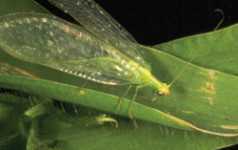Beneficial Of The Month: Green Lacewings

Identification
Green lacewings (Chrysoperia spp.) are common beneficial insects found throughout North America. Chrysoperia carnea, the common green lacewing, is the most widely available lacewing species. It is sold for general field and garden releases.
Adult green lacewings are about three-quarters of an inch in length; have delicate, light green bodies; large, clear wings; and bright, copper-colored eyes. The larvae are small, greyish brown, elongated, and have large, sickle-shaped mandibles. White eggs are laid singly or in small groups on plant stems and foliage and are attached to silken stalks to prevent the larvae from preying on each other and reduce predation and parasitism by keeping the eggs out of reach.
Survival And Spread
Larvae feed for about three weeks before pupating inside silken cocoons that are usually attached to the undersides of leaves. Although adults of some lacewing species are predaceous, Chrysoperia carnea adults feed only on nectar, pollen, and aphid honeydew and cannot produce eggs if these foods are not available.
Green lacewing adults make long dispersal flights soon after emerging from the pupal stage. Lacewings are night fliers and may travel many miles before mating and starting to produce eggs. Females are mobile throughout their egg-laying period, although they concentrate where nectar and honeydew are abundant.
Lacewings are usually purchased as eggs. They are shipped in a mixture of rice hulls and frozen (killed) caterpillar eggs. The caterpillar eggs provide food for the larvae that hatch during shipment, and the rice hulls keep the larvae separated to minimize cannibalism. Lacewings shipped in this manner are meant to be released as soon as hatching begins.
Beneficial Activity
Green lacewing larvae are generalist predators of soft-bodied insects, mites, and insect eggs. Field crop recommendations range from 50,000 to 200,000 lacewing eggs per acre. Releases are made singly or sequentially at two-week intervals, depending on the pest to be controlled. In field trials, lacewing releases have provided good control and significant increases in yields in some cases. However, the costs of purchasing and releasing such high numbers of lacewing eggs may be prohibitive for commercial use.
Lacewing larvae are naturally tolerant of low rates of several insecticides. Larvae are highly susceptible to many other insecticides, however, and adults tend to be more susceptible than larvae in all cases.
In almost all situations, encouraging or conserving naturally occurring populations of beneficial insects is critical. Conservation may be aided greatly by the use of selective, non-persistent insecticides and by the use of insecticides in a more selective manner.










